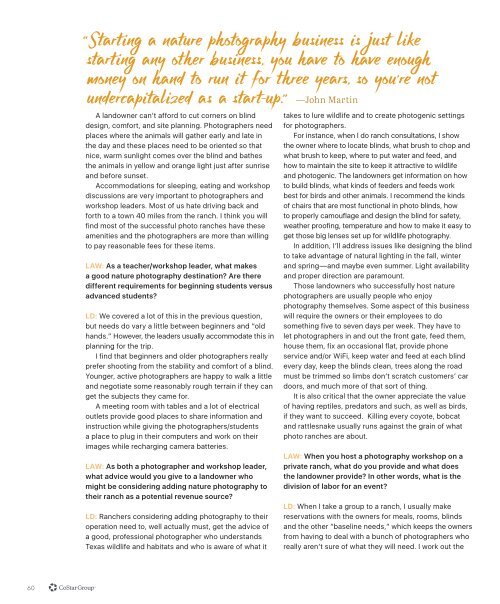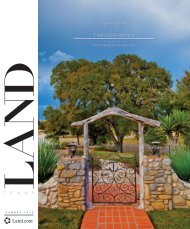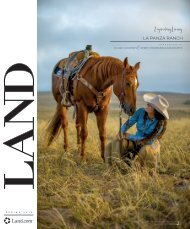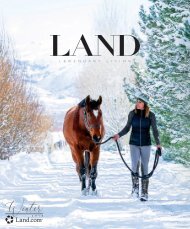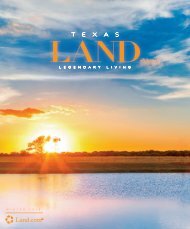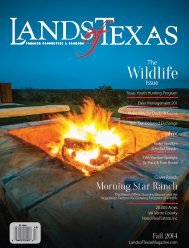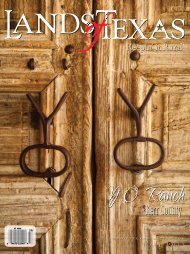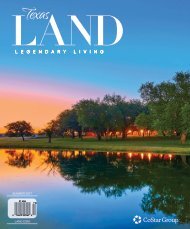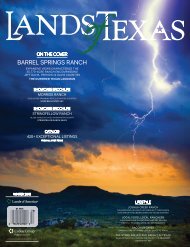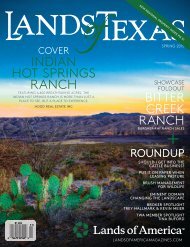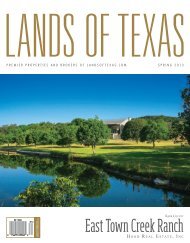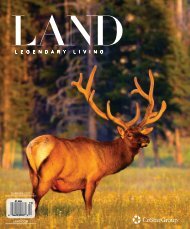Create successful ePaper yourself
Turn your PDF publications into a flip-book with our unique Google optimized e-Paper software.
“Starting a nature photography business is just like<br />
starting any other business, you have to have enough<br />
money on hand to run it for three years, so you’re not<br />
undercapitalized as a start-up.” —John Martin<br />
A landowner can’t afford to cut corners on blind<br />
design, comfort, and site planning. Photographers need<br />
places where the animals will gather early and late in<br />
the day and these places need to be oriented so that<br />
nice, warm sunlight comes over the blind and bathes<br />
the animals in yellow and orange light just after sunrise<br />
and before sunset.<br />
Accommodations for sleeping, eating and workshop<br />
discussions are very important to photographers and<br />
workshop leaders. Most of us hate driving back and<br />
forth to a town 40 miles from the ranch. I think you will<br />
find most of the successful photo ranches have these<br />
amenities and the photographers are more than willing<br />
to pay reasonable fees for these items.<br />
LAW: As a teacher/workshop leader, what makes<br />
a good nature photography destination? Are there<br />
different requirements for beginning students versus<br />
advanced students?<br />
LD: We covered a lot of this in the previous question,<br />
but needs do vary a little between beginners and “old<br />
hands.” However, the leaders usually accommodate this in<br />
planning for the trip.<br />
I find that beginners and older photographers really<br />
prefer shooting from the stability and comfort of a blind.<br />
Younger, active photographers are happy to walk a little<br />
and negotiate some reasonably rough terrain if they can<br />
get the subjects they came for.<br />
A meeting room with tables and a lot of electrical<br />
outlets provide good places to share information and<br />
instruction while giving the photographers/students<br />
a place to plug in their computers and work on their<br />
images while recharging camera batteries.<br />
LAW: As both a photographer and workshop leader,<br />
what advice would you give to a landowner who<br />
might be considering adding nature photography to<br />
their ranch as a potential revenue source?<br />
LD: Ranchers considering adding photography to their<br />
operation need to, well actually must, get the advice of<br />
a good, professional photographer who understands<br />
<strong>Texas</strong> wildlife and habitats and who is aware of what it<br />
takes to lure wildlife and to create photogenic settings<br />
for photographers.<br />
For instance, when I do ranch consultations, I show<br />
the owner where to locate blinds, what brush to chop and<br />
what brush to keep, where to put water and feed, and<br />
how to maintain the site to keep it attractive to wildlife<br />
and photogenic. The landowners get information on how<br />
to build blinds, what kinds of feeders and feeds work<br />
best for birds and other animals. I recommend the kinds<br />
of chairs that are most functional in photo blinds, how<br />
to properly camouflage and design the blind for safety,<br />
weather proofing, temperature and how to make it easy to<br />
get those big lenses set up for wildlife photography.<br />
In addition, I’ll address issues like designing the blind<br />
to take advantage of natural lighting in the fall, winter<br />
and spring—and maybe even summer. Light availability<br />
and proper direction are paramount.<br />
Those landowners who successfully host nature<br />
photographers are usually people who enjoy<br />
photography themselves. Some aspect of this business<br />
will require the owners or their employees to do<br />
something five to seven days per week. They have to<br />
let photographers in and out the front gate, feed them,<br />
house them, fix an occasional flat, provide phone<br />
service and/or WiFi, keep water and feed at each blind<br />
every day, keep the blinds clean, trees along the road<br />
must be trimmed so limbs don’t scratch customers’ car<br />
doors, and much more of that sort of thing.<br />
It is also critical that the owner appreciate the value<br />
of having reptiles, predators and such, as well as birds,<br />
if they want to succeed. Killing every coyote, bobcat<br />
and rattlesnake usually runs against the grain of what<br />
photo ranches are about.<br />
LAW: When you host a photography workshop on a<br />
private ranch, what do you provide and what does<br />
the landowner provide? In other words, what is the<br />
division of labor for an event?<br />
LD: When I take a group to a ranch, I usually make<br />
reservations with the owners for meals, rooms, blinds<br />
and the other “baseline needs,” which keeps the owners<br />
from having to deal with a bunch of photographers who<br />
really aren’t sure of what they will need. I work out the<br />
60


